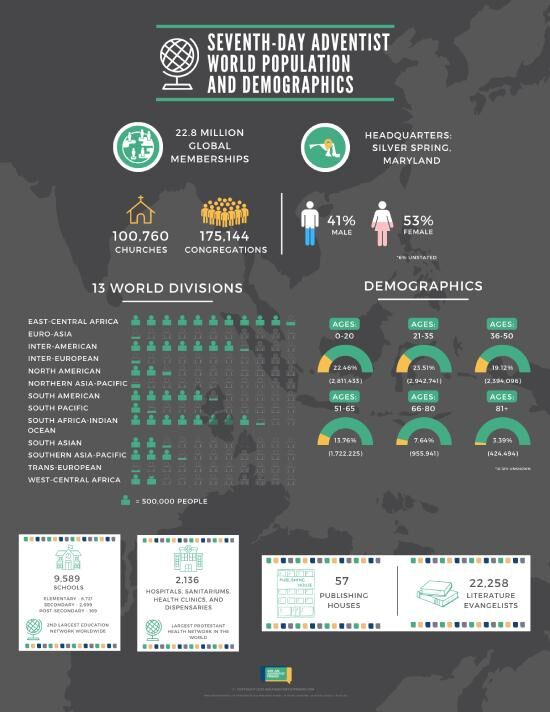Did you know that the Seventh-day Adventist Church has more churches around the world than the number of Pizza Hut, McDonald’s, and Subway restaurants combined?1
So how many churches is that exactly?
And how many people go to all those churches?
(And why would this be important?)
Let’s see what picture of the Adventist Church its current statistics paint for us. We’ll cover:
Let’s start with the membership count.
The Adventist population
As of the end of 2023, the world church had a total of 22,785,195 memberships.2 It shows how far we’ve come from our humble roots.
Seventh-day Adventism was started by Ellen G. White, James White, Joseph Bates, and several others in the 1840s after the Great Disappointment on October 22, 1844. Some Christians who followed William Miller thought this date marked the Second Coming of Jesus Christ.
Ellen White received the gift of prophecy, which helped guide the early Adventists in their journey of becoming a recognized church.
Although it had its roots in New England and later Battle Creek, Michigan, the Adventist Movement soon spread from coast to coast, then north and south and beyond the Americas. Today it is a global organization with its headquarters in the United States, in Silver Spring, Maryland.
Population by division
 To best serve its members in every part of the world, the Adventist Church separates the world into “divisions.” There are 13 divisions, along with a few other areas, recognized by the General Conference of Seventh-day Adventists.
To best serve its members in every part of the world, the Adventist Church separates the world into “divisions.” There are 13 divisions, along with a few other areas, recognized by the General Conference of Seventh-day Adventists.
- The East-Central Africa Division includes African countries between Eritrea and Tanzania and has 5,307,907 church memberships.
- The Euro-Asia Division covers Russia down to Afghanistan, along with some of the most eastern European countries like Belarus. 58,338 members call it home.
- The Inter-American Division encompasses all of Central America, the Caribbean, and the northernmost countries of South America. It has 3,705,040 members.
- The Inter-European Division includes much of Continental Europe, from Portugal to Germany. It has 181,586 members.
- The North American Division spans all of North America and is home to 1,257,884 members.
- The Northern Asia-Pacific Division includes China, Mongolia, the Koreas, Japan, and Taiwan. 356,203 members live there.
- The South American Division includes every country from Brazil south and has 2,679,791 members.
- The South Pacific Division is made up of Australia and all the Pacific Islands. It has 650,632 members.
- The South Africa-Indian Ocean Division is made up of the bottom tip of Africa and the nearby islands. 4,213,158 members live here.
- The Southern Asia Division is mostly made up of India and a few surrounding countries. It has 1,161,806 members.
- The Southern Asia-Pacific Division is composed of the southern Asian countries and the larger islands like the Philippines and Indonesia. 1,594,150 members live there.
- The Trans-European Division has countries from all over Europe, including the United Kingdom, Nordic countries, and southern European countries. There are 90,510 members there.
- The West-Central Africa Division includes the African countries from Congo and west to Senegal and Gambia. There are 998,383 members in this division.3
Although the lack of religious liberty in some countries has restricted our work, we still seek to do what is possible with the means we have.
Since we’ve seen some statistics for members, let’s look at some of the types of institutions the Adventist Church has around the world.
Churches
As of 2023, the Church operates 100,760 churches.4
However, not every group of members has a church building. They may meet in houses or other buildings, which is why the total number of congregations, as opposed to stand-alone churches, is 175,144.5
In the United States and Canada alone there are 6,636 congregations.6
Hospitals
The number of hospitals and sanitariums we operate is 230. We also have 1,906 medical clinics and dispensaries to serve the communities they’re a part of.7
Some of our biggest hospitals include Loma Linda University Medical Center in Loma Linda, California, and AdventHealth Orlando in Orlando, Florida.
Adventists believe health is crucial—not only physical health but spiritual and mental as well. That’s why the Adventist Church operates a large network of hospitals and health clinics around the world. With these healthcare facilities, we can not only heal people but also use the time together for evangelism.
We are so focused on this mission to serve that our network has become the largest Protestant health network worldwide.
Schools
 According to data from the end of 2021, the Adventist Church operates a total of 9,589 schools. Of those, 6,721 are elementary schools, 2,699 are secondary schools, and 169 are post-secondary schools.8
According to data from the end of 2021, the Adventist Church operates a total of 9,589 schools. Of those, 6,721 are elementary schools, 2,699 are secondary schools, and 169 are post-secondary schools.8
Some of the most well-known Adventist schools are Loma Linda University in Loma Linda, California, Andrews University in Berrien Springs, Michigan, and Avondale University in New South Wales, Australia.
Within all those schools, we are educating a total of 2,064,761 students.9
Along with health, Adventists also highly value education. Education gives us the tools necessary to make good use of the talents God gives us and to work with other Christians for the ultimate goal: bringing others to Christ.
It can be used as a form of missionary work for whatever we choose to do in our lives.
The effort to educate young people around the world has made us the second-largest education network worldwide.
Publishing houses
According to 2021 data, 57 publishing houses and their branches exist globally. In order to take these publications to the general public and beyond, a total of 22,258 literature evangelists work among the many countries Adventism has touched and is touching.10
One big publishing house is the Pacific Press Publishing Association in Nampa, Idaho.
The Adventist Church also owns and runs many of its own publishing houses. These companies print many types of materials for the church, including outreach materials, Sabbath School lessons, Ellen White’s writings, Bibles, and other literature.
Now that we’ve taken some time to explore some institutions within the church, let’s look at the demographics of the Adventist Church, where we’ll celebrate our diverse populations all over the world.
Demographics of the Adventist Church
The population of the world church is almost evenly split between men and women, with 41% male and 53% female (and 6% unstated).11
Since the Adventist Church spans the globe, it represents an enormous variety of ages, races, and other demographics.
The church splits age statistics into six categories. In 2022, newborns to age 20 comprised 22.46% of the population. Ages 21 to 35 were slightly higher at 25.31%, while ages 36-50 were lower, at 19.12%.12
Ages 51-65 made up 13.76%, though ages 66-80 made up only 7.64%, and any older were at 3.39%. There was also a number of unknown ages making up 10.12%, which does not include those divisions without records.13
The table below shows the number of people that comprise each age group.
| Age Range | Percent of Population | Number of People |
| 0-20 | 22.46% | 2,811,433 |
| 21-35 | 23.51% | 2,942,741 |
| 36-50 | 19.12% | 2,394,096 |
| 51-65 | 13.76% | 1,722,225 |
| 66-80 | 7.64% | 955,941 |
| 81+ | 3.39% | 424,494 |
| Unknown | 10.12% | 1,267,302 |
Aside from the world church, extensive research has been conducted on the North American demographic. The Center for Creative Ministry did a study of North American Adventists in 2018. Here is a breakdown of what they found:
- Age: the largest number of Adventists was between 54-72 years of age with 40%. The range of 73 and older had the next highest at 23%.14

- Race: Although black and multiple ethnicity populations are growing, white is the highest at 54.1%.15 Even then, Adventism is the most racially diverse religion in the United States.16

- Marital status: 79% of Adventists are married, with low rates of divorced, single, and widowed17 compared to the United States in general.18

The Adventist Church, as we can see, is diverse in many areas.
With so many different backgrounds, we can use our diversity to bring many different ideas to the table. And we all unite for a single purpose: to tell others about Jesus.
Adventist population compared to other denominations
Let’s take a look at the world population of some of the other big denominations.
- The Adventist population was 22,785,195 at the end of 2023.
- Catholicism, as of the end of 2021, had 1.38 billion members.19
- The Anglican Church had 85 million members in 2019.20
- Lutheranism had 77 million members in 2019.21
- Also in 2019, the Presbyterian Church had 75 million members.22
- The Baptist World Alliance tallied 51 million members.23
- The Methodist World Council had 39,745,196 members as of 2016.24
Compared to other major Christian groups, the Adventist Church has a smaller membership. But we are continuing to grow, especially in Africa and Asia.
Within these worldwide numbers, let’s focus on the United States and compare the number of churches or congregations.
- The Adventist Church has 6,636 congregations.
- The different Baptist groups have over 60,000 churches.25
- Catholicism claimed 17,755 parishes in 2014.26
- The United Methodist Church reported 29,746 active churches in 2022.27
- Presbyterians attended 8,813 churches in 2021.28
- The Anglican Church had 974 churches in 2021.29
- The Evangelical Lutheran Church has nearly 10,000 churches.30
Since the Adventist population is smaller than some of these other major denominations but has a fairly comparative number of churches in the US, it means many of our churches have a smaller number of members than churches of other denominations.
This allows you to get to know the members of your church better and form closer connections with your entire church body as a whole.
With God as our center, we can work together to fulfill our mission as Christians and Adventists and bring the message of Christ to our dark world, whether through church, ministry, healthcare, or education.
If you’d like to learn more about the inner workings of the Adventist Church,
Find a Church
If you’re interested in finding a local Adventist church near you, you can use the Adventist Locator provided by the General Conference of Seventh-day Adventists.
Related Articles
- Angeles, Samantha with “Reaching Millennial Generations: Ministry Leaders from Around the World Gather at Andrews University,” North American Division of the Seventh-day Adventist Church, May 18, 2018. [↵]
- 2024 Annual Statistical Report New Series, Volume 6, Seventh-day Adventist Church Office of Archives, Statistics, and Research. [↵]
- Ibid. [↵]
- Ibid. [↵]
- Ibid. [↵]
- Ibid. [↵]
- “Seventh-day Adventist World Church Statistics,” Seventh-day Adventist Church Office of Archives, Statistics, and Research. [↵]
- Ibid. [↵]
- Ibid. [↵]
- Ibid. [↵]
- 2023 Annual Statistical Report New Series, Volume 5, Office of Archives, Statistics, and Research. [↵]
- Ibid. [↵]
- Ibid. [↵]
- “2018 North American Adventist Demographics,” Center for Creative Ministry. [↵]
- Ibid. [↵]
- Lipka, Michael with “The Most and Least Racially Diverse U.S. Religious Groups,” Pew Research Center, July 27, 2015. [↵]
- “2018 North American. [↵]
- “Marriage and Divorce,” CDC, March 13, 2024. [↵]
- Krapic, Nina Benedictka with “Global Catholic population rising as number of priests, religious falls,” Vatican News. [↵]
- “The Anglican Communion,” The Archbishop of Canterbury. [↵]
- “More than 77 million Lutherans in 148 LWF member churches,” Lutheran World Federation, July 22, 2020. [↵]
- Fairchild, Mary, “Presbyterian Church Denomination,” Learn Religions, April 25, 2019. [↵]
- “Member Unions,” Baptist World Alliance, Accessed April 16, 2024. [↵]
- “Statistical Information,” World Methodist Council. [↵]
- “Baptist Church,” New World Encyclopedia. [↵]
- “Laity and Parishes,” United States Conference of Catholic Bishops. [↵]
- “United Methodists At-A-Glance,” The United Methodist Church. [↵]
- “PC(USA) 2021 statistics continue to show declining membership,” Presbyterian Church (USA). [↵]
- “Congregational Reporting Results from 2021,” Anglican Church in North America, June 15, 2022. [↵]
- “Home – Evangelical Lutheran Church in America,” ELCA. [↵]
More Answers
Do Seventh-Day Adventists Have “Rules” For Clothing?
Many religions have guidelines on dress, but what about the Adventist Church? Discover how Adventists choose to dress based on biblical principles.
11 Reasons People Become Seventh-day Adventists
Curious why many people become Adventists? Here are elements of Adventist beliefs, values, and mission often reflected in people’s decisions to join.
What’s the Seventh-day Adventist General Conference Session?
At the General Conference Session, Adventist delegates from around the world gather to assess the state of the organization, pray, and discuss current issues. Here’s how it works.
How Adventists View the End of the World
The end of the world is no fun to think about. But here’s how we can actually find hope and comfort in what’s to come.
What Is an Adventist Medical Missionary?
A medical missionary in the Adventist Church is someone who cares for the medical needs of people as a way of showing the love of Jesus. They may travel to another country, or even just serve in their hometown.
Is the Seventh-day Adventist Church Protestant?
Learn how the beliefs of the Seventh-day Adventist Church align with the “5 solas” of Protestantism.
Are Seventh-day Adventists Evangelicals?
According to its origins and definition, evangelicalism is about following Jesus and the Bible and sharing the Gospel through the way we live our lives. Adventists wholeheartedly harmonize with these principles.
Could Anything Keep Me from Becoming an Adventist?
We are each saved through Christ. But when it comes to church membership, are there certain beliefs or expectations to become an Adventist?
Do Seventh-day Adventists Have “Rules”?
We uphold principles we believe will help us maintain a closer relationship with Jesus and His Word. Learn how these principles guide Adventist lifestyles.
Do Seventh-day Adventists Have “Rules” For Marriage?
Around the world, many cultures and religions have various marriage traditions, expectations, or even rules when it comes to choosing a partner, planning the wedding, extended family logistics, or a number of other things.
Can a Seventh-day Adventist Marry a Non-Adventist?
Yes. Seventh-day Adventists are not under any official rules that dictate who they can or cannot marry. This is a personal, life-altering decision between the couple and God.
What Adventists Believe About Alcohol and Tobacco Use
The Seventh-day Adventist Church has historically discouraged the use of alcohol and tobacco. Even before the church started in 1863, its leaders were realizing the negative effects of these substances.
Jewelry—Why Do Many Seventh-day Adventists Choose Not to Wear It?
If you walk into a Seventh-day Adventist church service, you might notice that many people aren’t wearing earrings, bracelets, necklaces, or sometimes even wedding rings.
International Pathfinder Camporee
Youth aged 10-15 in the Adventist Church’s global Pathfinder program look forward to the International Camporee every 5 years. This event brings together Pathfinders from around the world for exciting activities.
How Adventists interpret Bible prophecy
Bible prophecy conjures up a variety of emotions in people. For some, it feels exciting or mysterious.
Moviegoers’ Guide to The Hopeful: The Facts Behind the Film
Learn where and when you can watch The Hopeful and how to get tickets. Already seen it? We’ll uncover the real story that inspired this film.
How Are Seventh-day Adventists Different from Other Protestants?
As a Protestant Christian denomination, the Seventh-day Adventist Church regards the Bible as the ultimate guide and looks to Jesus Christ as the only way to salvation. We do have some differences of belief or interpretation when it comes to topics like Bible prophecy, end-time events, the Sabbath, and a person’s state after death.
How Adventists Handle Death and Funerals
Most Seventh-day Adventist funeral services are similar to those of other Protestant denominations, such as Methodists, Baptists, or Presbyterians, but you might find a few differences or unique nuances.
Adventist Culture
Many Seventh-day Adventists adhere to specific lifestyle principles that can make them stand out from those in other Christian denominations. Whether it’s going to church services on Saturday or eating the popular Adventist entrée of “haystacks.”
Do Adventists Observe Easter-Related Holidays?
Jesus Christ’s resurrection, celebrated on many Easter-related holidays, is central to the beliefs of the Seventh-day Adventist Church. And that means we seek every opportunity to remember it.
An Overview of Seventh-day Adventist Higher Education
The Seventh-day Adventist Church has about 118 tertiary schools around the world. Though many of them are within North America, you’ll also find Adventist universities in countries across the world—places like Croatia, Austria, Brazil, Madagascar, and the Philippines.
The Ten Commandments from a Seventh-day Adventist Perspective
Ever eaten a salad and gotten a big piece of green stuck in your teeth? And you didn’t realize it was there until you looked in the mirror? (Because no one ever told you!)
The Benefits of A Seventh-day Adventist Academy
Adventist academies are high schools (grades 9-12) that are owned and operated by the Seventh-day Adventist Church.
Are Seventh-day Adventists Christians?
Yes, the Seventh-day Adventist Church is a Protestant Christian denomination formed in 1863. Just like other Christians, we believe that Jesus Christ is our Savior and seek to follow the principles of the Word of God.
Adventist Movies: Where Faith and Film Meet
The Adventist Church uses film to share our faith and uplift positive values. Learn more about specific Adventist-produced films and where to find them.
Do Adventists Celebrate Christmas?
In general, most Seventh-day Adventists do celebrate Christmas.
Since our denomination doesn’t have specific guidelines about holidays, it’s up to each member to decide whether to celebrate it based on their personal convictions and study of the Bible.
What Does the Bible Say About Modesty
Seventh-day Adventists and Christians in general try to ensure their outward presentation and lifestyle glorify God. This often involves daily habits like the ways we hold conversations, the ways we dress and accessorize, and the ways we regard other people when we’re out and about.
How Do Adventists Make Movie and Music Choices?
How do Adventists decide what music to listen to and which movies to watch? Learn how Bible principles can help us make better entertainment choices.
Does the Seventh-day Adventist Church Believe in Paying Tithe?
Seventh-day Adventists believe in paying tithe and offerings based on the biblical command and our commitment to being wise stewards of God’s resources. These donations help fund the mission of the Adventist Church by supporting pastors, missionaries, church expenses, and evangelistic projects, among other things.
Didn’t find your answer? Ask us!
We understand your concern of having questions but not knowing who to ask—we’ve felt it ourselves. When you’re ready to learn more about Adventists, send us a question! We know a thing or two about Adventists.































